By Pete Salmansohn
Hidden in the thousands of acres of Fahnestock Park and surrounding highlands are animals few of us see on a regular basis: bobcats, coyotes, owls, foxes. We know they’re out there, because some of us are lucky enough to hear coyotes howling at night, or we happen to glimpse a fox or bobcat dart across the road on a misty night, giving us a half-second look at their ghost-like, fleeting presence. The woods hold many secrets, and we’re all indebted to the many known and unknown heroes and heroines who worked hard and long over the past 90 years to create a large, relatively undeveloped state park here in Putnam County.
An exciting new use of photographic technology is now revealing the secretive and wary creatures that live in this large protected area and is providing us with rare images that could not have been gotten otherwise.
The photos displayed here come from a Bushnell “trail cam” set up on a frozen lake and trained on several adjacent deer carcasses, which were road kills and were then purposefully put there. Naturalists from the Taconic Outdoor Education Center arranged the camera and carcasses in early February, and the very first animals seen in daylight visiting this free meal were crows.
Two nights later, as seen in these infrared images, two coyotes, a red fox and a large bobcat showed up, and from what we can infer here, the bobcat was holding the coyotes at bay, at least for a time, while defending the large bounty of fresh deer meat. Soon thereafter, a great-horned owl was seen sitting on the carcass itself — an unusual sighting because owls are predators and are not typically known to scavenge. Bald eagles, both juveniles and adults, visit the carcass regularly, and they are often joined by crows and ravens, though the crows typically keep their distance from these larger birds. Red-tailed hawks, a raccoon and turkey vultures have also visited the deer, though as naturalist Nicole Passeri said, “Each day is a surprise, and we’re all excited to see exactly who showed up.”
The trail cam can be set to take photos every five or ten seconds (or other programmable period of time) and is controlled by a motion sensor. This creates a great challenge the next day, when Taconic’s staff members look over perhaps 2,000 images collected the night or day before, on the camera’s 8-GB memory card, as viewed on a computer.
Naturalists Passeri, John Stowell, Elijah Kruger, Greg Soyk, Victoria Londner, AJ Johnson and Mary Ronan all contributed to the camera’s operation and the time-consuming editing of the photographs. Said Stowell, “Holy cow, I never thought we would capture a photo of a bobcat on the bait, let alone one with two coyotes in the same frame!”
Photos by Taconic Outdoor Education Center

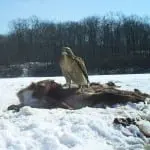
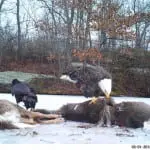
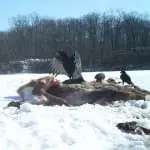
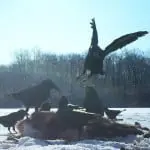
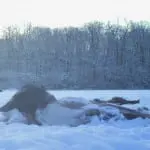
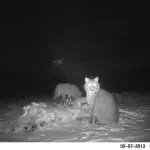
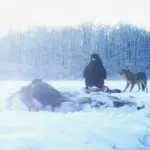
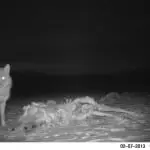
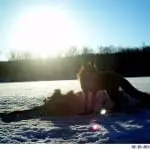
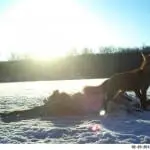
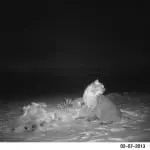
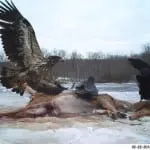
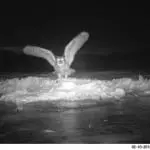
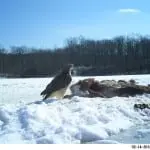
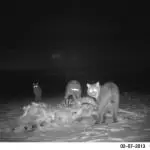
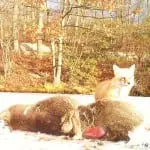
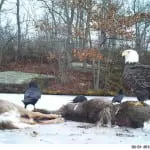

Wow. Thank you for introducing us to some neighbors we rarely get to see. Wonderful that you have shared these images here.
This is phenomenal. Thank you Pete and all the folks at the Taconic Outdoor Education Center. Remarkable images of seldom seen creatures. Yet, part of me was happy, and not surprised, that the crows were the first to the table. This work deserves an award.
Stunning. Thank you so much for sharing this. I hope more from the Bushnell will follow!
Wonderful project. Thanks Pete. Those photos are amazing to view. Pete is an asset to the community.
Absolutely amazing! Thanks for the article and for letting us know about all this wildlife in nearby Fahnestock. The eagles are incredible and I had no idea there are bobcats in the neighborhood. Great work from all who contributed to article and of course, the writer.
Articles like this make Philipstown a better place!
These are wonderful! Such a treat to see what happens when we aren’t there in person. Love it.
Absolutely wonderful images. Thank you to Pete and everyone at TOEC for giving us a peek at our more reticent neighbors.
Pete, great article and pictures. John and I forwarded it to Glenn Powers, the 5-6 grade teacher at CTL. His group is studying Maine wildlife as we speak. He is taking them to HVNC every week, and has written an article called 40 days in the Maine Woods. Look it up!
This is amazing! The students would love a photo expo of this!
These have to be nominated for pictures of the year.
I am a Park Police Officer who patrols Fahnestock and regularly see red-tailed hawks and turkey vultures, I occasionally see Cooper’s Hawks and broad-winged hawks but I have never seen an eagle, mature or juvenile, or a bobcat or an owl. I have only seen one coyote and one fox. No bears either, even though people report regular sightings. These pictures are awesome, hope to see more.
Fantastic! I loved this article and the accompanying photos. The parkland and woodlands, the trails and wildlife are such a treasure to Philipstown. I would love to see more articles like this in the future.
Great images Pete! I would love to have you come in and share your experience using the cams with my students. We have been conducting a trail cam study with the woods surrounding Haldane as well! you check the images out at haldanenaturetrail.weebly.com under the animals tab.
Pete, even though I have known you my entire life, I am thoroughly thrilled to be your brother and see life through your eyes for a minute. The passion and excitement you bring from the natural world to your “audience” is always wonderful and surprising. May you always bring the beauty and innocence of your love for nature to us all.
Great shots. I live in Maryland now but learned to ski at Fahnstock back in the 1960s.
I didn’t at all expect to see an eagle in the collection. Well done!